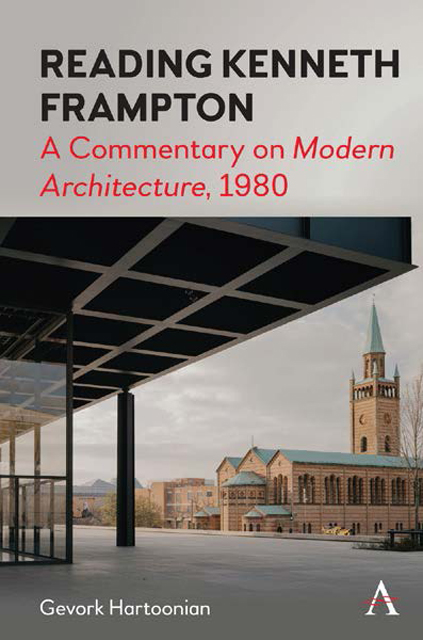3 - The Vicissitudes of a Critical History
Published online by Cambridge University Press: 09 December 2022
Summary
Opening
Under the umbrella title of “A Critical History,” part II of Kenneth Frampton's Modern Architecture (1980) comprises 27 chapters, each of which focuses on the work and contribution of a particular architect or architects and thinkers associated with a tendency or a movement. The present chapter neither presents a detailed discussion of each chapter of this section of Frampton's book nor examines the extent to which the two major architectural trajectories of modernism outlined in the introduction to the book inform Frampton's take in each chapter. What it does instead is to present a close reading of the ways that a few protagonists cast light on the proposed “Aalto contra Mies” paradox. Central to this inquiry is the ideology of architecture, especially in the politics of public space, the Arendtian “space of public appearance,” that Frampton has even pursued its dialectical relevance for the private nature of domestic space. Following this line of consideration, ample attention is given to Frampton's discussion of Giuseppe Terragni's Casa del Fascio (Figure 3.1), a project charged with civic and political connotations—and this concerning the concept of “monumentaliazation” introduced in connection with the late work of Mies van der Rohe and Le Corbusier, discussed in the next chapter. What is involved here is a constellation of themes, if you wish, that anticipate Jürgen Habermas's annunciation of “Modernity—an Incomplete Project.” To start with, the historicity of the annotated period is mapped at the expense of exceeding the scope of disciplinarity, keeping in mind that autonomy is a grey zone informed by history and the contingencies of the present time, the Benjaminian “now-time” (Jeztzeit).
At the outset, the importance of the epoch-making decade of the 1930s is highlighted. During this time, the revolutionary specter haunting Europe since the end of World War I culminated in crisis, aspects of which Walter Benjamin unpacks in his famous essay “The Work of Art in the Age of Mechanical Reproduction,” first published in 1936. Conversely, this is also the moment when the architecture of Europe and America cultivated the formative ethos of modernism. In retrospect, the ideological apparatus of the contingencies of the project of modernism did foreground various stages of contemporary architecture.
- Type
- Chapter
- Information
- Reading Kenneth FramptonA Commentary on 'Modern Architecture', 1980, pp. 59 - 80Publisher: Anthem PressPrint publication year: 2022



